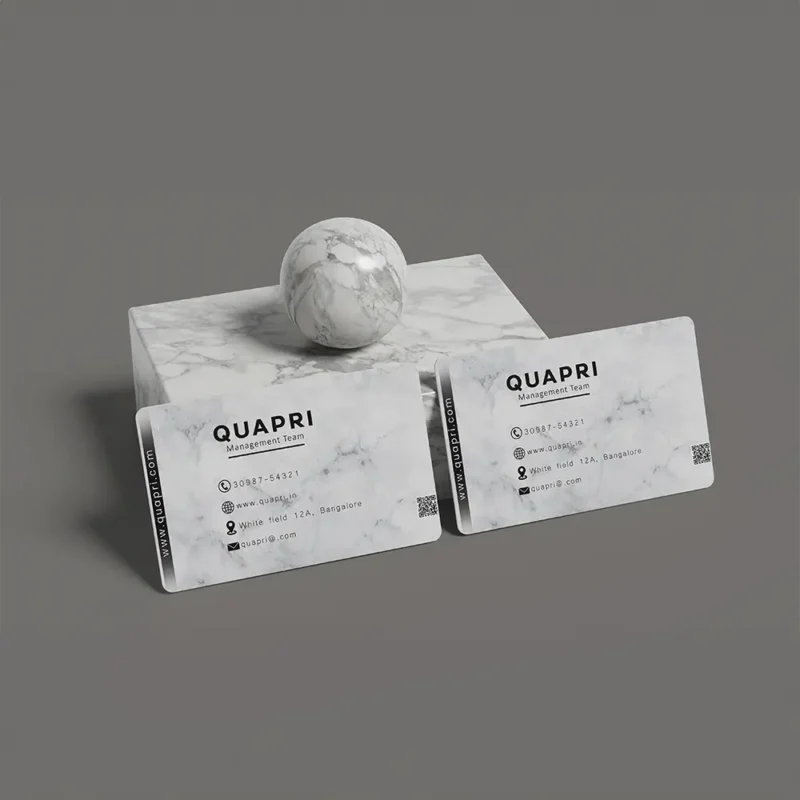What Information Should You Put on a Business Card ?
Business cards are essential for making a strong first impression in the professional world. Whether you're networking at an event, meeting clients, or exchanging details with a colleague, your business card says a lot about you. With so many details to consider, it’s important to know What Information Should You Put on a Business Card to make it effective.
In this blog, we'll go over the key elements you should add to your business card, ensuring it represents you and your brand perfectly. Let’s dive in!
What Should Be Included on the Front of Your Business Card?
1. Your Name
Your name is the most important detail on your business card. Whether you're a freelancer, entrepreneur, or corporate professional, it should be the first thing people see. Use a bold, large font to make your name stand out. If relevant, add titles like "CEO," "Consultant," or "Marketing Specialist" to show your expertise. This helps establish your authority in your field. If your name is unique or hard to pronounce, consider adding a phonetic spelling to make it easier for others to say. A clear name sets the tone for your professional business card.
2. Your Job Title or Position
The next important detail is your job title. This tells people what you do and your role within your company or organization. Whether you're a business owner, manager, or executive, your title adds context to your name and helps others understand your role when they reach out. For example, if you’re a web designer, use titles like "Lead Web Designer" or "Senior UI/UX Designer" to highlight your expertise.
Tip: Keep your title short and clear so others can quickly understand your role.
3. Your Business Name
For business owners or employees, including your business name is essential. It strengthens your connection to the company and builds credibility. Ensure the business name is legible and stands out, making it easy for others to recognize your brand. You can place it beneath your title or near your contact details, depending on the design. For small business owners, a larger company name helps promote the brand.
Tip: Adding your company logo enhances the card’s appeal and memorability.
4. Your Logo
What Information Should You Put on a Business Card ? Including your logo is one of the best ways to boost brand recognition. Logos serve as a visual representation of your business, making it easier for people to remember you. Place your logo in a prominent spot, like the top left or right corner of your business card, to make it easily identifiable.
Tip: Ensure the logo is the right size—too big, and it overwhelms the design; too small, and it won’t be noticed.
What Should Be Included on the Back of Your Business Card?
5. Contact Information
Business cards are all about contact, so it’s essential to include the right information that allows people to reach you easily. This could include several ways to get in touch, such as:
Phone number: A direct line to your business or mobile phone number.
Email address: A professional email address is crucial, ideally one with your company’s domain name.
Website URL: A link to your business website or portfolio, providing further information about your services or products.
Make sure the contact details are clear and easy to read. Avoid cluttering your card with multiple phone numbers or email addresses unless it’s necessary for your business.
Tip: Ensure that your phone number is international, especially if you deal with clients globally. Include international phone numbers if relevant.
6. Social Media Handles
What Information Should You Put on a Business Card ? In today’s digital age, your social media profiles can be as important as your business card. Many professionals and businesses use social media to showcase their work, communicate with clients, and even advertise services. Including social media links on your business card can help others connect with you online.
Make sure you include your primary platforms, such as LinkedIn, Twitter, Instagram, or Facebook. Only include platforms that align with your business and professional goals.
Tip: Include social media handles that are appropriate for business interactions. Personal accounts might not be suitable to include, especially for more formal industries like professional services or consulting.
7. Physical Business Address (Optional)
While less common in the digital world, including a physical address on your business card might still be relevant in some industries, especially if you have a storefront or office. This is particularly important for local businesses or professionals who want clients to know where they’re based.
However, if your business operates remotely or doesn’t require an address, you can skip this. Many people are more likely to contact you digitally, and in such cases, an address might feel unnecessary.
Tip: If you include an address, make sure it’s current and correct. Keep your business contact information updated to maintain professionalism.
8. Call to Action (CTA)
What Information Should You Put on a Business Card ? A business card can do more than just provide contact details. Adding a subtle call to action (CTA) can be a great way to encourage follow-up actions. This could be something simple like:
“Visit our website for a free consultation.”
“Follow us on LinkedIn for industry updates.”
“Contact me for your custom design needs.”
By including a CTA, you're giving people a reason to engage further with your business, increasing the likelihood of a continued relationship.
Tip: Keep your CTA short and direct, and make sure it’s relevant to your target audience. Including a CTA can drive more business inquiries and potential collaborations.
9. Professional Design Services
Finally, if you’re still unsure about the design or content of your business card, you can always reach out to professionals who specialize in card design. A well-designed business card can make a significant difference in your branding efforts, and working with a designer can help you get the most out of your investment.
Tip: Quapri, known for its high-quality business card printing services, can help you create the perfect card that reflects your brand identity. Whether you're looking for premium business cards, matte finishes, or customized designs, Quapri can provide the expertise you need to ensure your card makes the right impression.
What’s Next? Let Us Help You Make the Perfect First Impression!
Ready to design your own business card and leave a lasting impact? With Quapri’s expert design and printing services, you can create a business card that’s as unique as your brand. Your design, your message, your style—Quapri customized to perfection! Contact Quapri today, and let’s bring your vision to life!
Explore the Quapricatalogue.com for top-quality, customizable products and printing services for every need!
Table of Contents
Classic Business Cards
From ₹2.00 per unit
Glossy Business Cards
From ₹1.80 per unit
Matte Visiting Cards
From ₹1.80 per unit
Rated 5.00 out of 5
Non-Tearable Visiting Cards
From ₹3.35 per unit
Premium Laminated Cards
From ₹3.30 per unit
Premium Visiting Cards
From ₹2.60 per unit
QR Code Business Cards
From ₹1.70 per unit
Raised Foil Visiting Cards
From ₹7.50 per unit
Rounded Corner Visiting Cards
From ₹2.20 per unit
Rated 5.00 out of 5
Spot UV Business Cards
From ₹12.15 per unit
Square Visiting Cards
From ₹2.20 per unit
Rated 5.00 out of 5
Standard Visiting Cards
From ₹1.80 per unit
Textured Business Cards
From ₹4.42 per unit
Premium Business Cards – Stand Out with Unique Finishes
- Paper Thickness: 350 GSM
- Final Size: 89mm x 54mm (after printing and cutting)
- Textures: Natural Evaluation, Cream, Criss Cross, White, Needle Point, Textured Canvas
- Customization: Various shapes, sizes, and designs
- Print Quality: Sharp and vibrant colors
Transparent Visiting Cards
From ₹9.00 per unit
Presenting transparent business cards—a novel option for contemporary businesses.
- Made from 135-micron clear plastic, these cards are slightly thinner than standard credit cards.
- Waterproof and incredibly durable, they offer long-lasting quality.
- They have a polished, professional design.
- Transparent business cards have conventional dimensions of 89mm x 54mm.
Velvet Touch Visiting Cards
From ₹2.70 per unit









































































